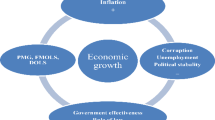Abstract
This paper shows that there exists a long-run equilibrium relationship between M2 and its determinants, real income and the long-term interest rate, in Korea by using Johansen and Juselius maximum likelihood cointegration method. However, M1 does not have any meaningful cointegration relationships with its determinants. The long-term interest rate is a better proxy than the short-term rate to measure the opportunity cost of holding money. Based on the results, a broad definition of money is a better measure than a narrow definition of money in considering the long-run economic impacts of changes in monetary policy in Korea.
Similar content being viewed by others
References
Bahamani-Oskooee, M.; Rhee, Hyun-Jae. “Long-Run Elasticities of the Demand for Money in Korea: Evidence from Cointegration Analysis,”International Economic Journal, 8, 1994, pp. 83–93.
Dickey, David; Jansen, Dennis; Thornton, Daniel. “A Primer on Cointegration with an Application to Money and Income,”Review, Federal Reserve Bank of St. Louis, 73, 1991, pp. 58–78.
Engle, R. F.; Granger, C. W. J. “Co-Integration and Error Correction: Representation, Estimation, and Testing,”Econometrica, 55, 1987, pp. 251–76.
Fair, Ray C. “International Evidence on the Demand for Money,”Review of Economics and Statistics, 74, 1987, pp. 473–80.
Funke, Norbert; Thornton, John. “The Demand for Money in Italy, 1861–1988,”Applied Economics Letters, 6, 1999, pp. 299–301.
Hafer, R. W.; Jansen, D. W.. “The Demand for Money in the United States: Evidence from Cointegration Tests,”Journal of Money, Credit and Banking, 23, 1991, pp 155–68.
Hoffman, D. L.; Rasche, R. H. “Long-Run Income and Interest Elasticities of Money Demand in the United States,”Review of Economics and Statistics, 78, 1991, pp. 665–74.
Hoffman, D. L.; Rasche, R. H.; Tieslau, M. A. “The Stability of Long-Run Money Demand in Five Industrial Countries,”Journal of Monetary Economics, 35, 1995, pp. 317–39.
Johansen, S. “Statistical Analysis of Cointegrating Vectors,”Journal of Economic Dynamics and Control, 12, 1988, pp. 213–54.
Johansen, S.; Juselius, K. “Maximum Likelihood Estimation and Inference on Cointegration-with Application to the Demand for Money,”Oxford Bulletin of Economics and Statistics, 52, 1990, pp. 169–210.
Lee, Tong Hun; Chung, Keun Jon “Further Results on the Long-Run Demand for Money in Korea: A Cointegration Analysis,”International Economic Journal, 9, 1995, pp. 103–13.
Miller, S. M. “Monetary Dynamics: An Application of Cointegration and Error Correction Modeling,”Journal of Money, Credit, and Banking, 23, 1991, pp. 139–54.
Weliwita, A.; Ekanayake, E. M. “Demand for Money in Sri Lanka During the Post-1977 Period: A Cointegration and Error Correction Analysis,”Applied Economics, 30, 1998, pp. 1219–29.
Author information
Authors and Affiliations
Rights and permissions
About this article
Cite this article
Hwang, JK. The demand for money in korea: Evidence from the cointegration test. International Advances in Economic Research 8, 188–195 (2002). https://doi.org/10.1007/BF02297956
Issue Date:
DOI: https://doi.org/10.1007/BF02297956




